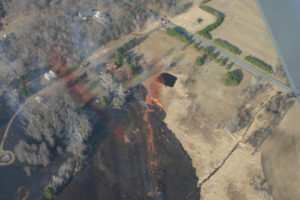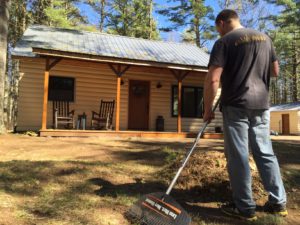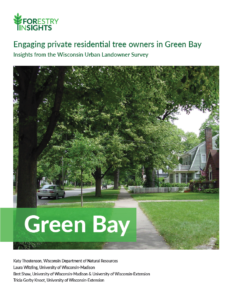A draft update of Wisconsin’s Forest Management Guidelines is available for public comment. See a description of the proposed changes and an updated draft of the publication here. Submit your comments to Rob Anderson by June 6, 2018. This revision focuses on updating outdated information and adding relevant new information. Future updates of the publication will be made on a chapter-by-chapter basis to reflect recommendations from the Wisconsin Forest Practices Study.
Month: May 2018
Wisconsin delegation explores China market
A delegation of six forestry businesses from Wisconsin, along with representatives from the Department of Agriculture, Trade, and Consumer Protection and Scott Lyon from the Department of Natural Resources, participated in a trade mission to China on March 20-April 4, 2018. The purpose was to explore and expand markets for Wisconsin’s forest products. Continue reading “Wisconsin delegation explores China market”
Midwest Biomass Exchange
 Looking for outlets for selling mill residues this year? Check out the updated Midwest Biomass Exchange – a free online marketplace designed to help buyers and sellers of woody and agricultural biomass. Users can place ‘For Sale’ and ‘Wanted’ ads for selling biomass that can be used as fuel for heating and power generation, or as feedstock for other manufacturing processes.
Looking for outlets for selling mill residues this year? Check out the updated Midwest Biomass Exchange – a free online marketplace designed to help buyers and sellers of woody and agricultural biomass. Users can place ‘For Sale’ and ‘Wanted’ ads for selling biomass that can be used as fuel for heating and power generation, or as feedstock for other manufacturing processes.
The site is hosted by Heating the Midwest, Inc., a non-profit organization dedicated to promoting the use of woody and agricultural biomass for thermal energy and power. Updated from the old Minneapolis Biomass Exchange, the new site focuses more closely on biomass that can be used for fuel, and on serving the Midwestern area in the USA and Canada. For more information, visit the site or contact Dave Neumann at neumannd@michigan.gov.
By Forest Products Specialist Sabina Dhungana, Sabina.dhungana@wisconsin.gov, (608) 220-4531
Survey coming for secondary wood manufacturers
Wisconsin Department of Natural Resources – Division of Forestry and University of Wisconsin-Wood Products Extension will be conducting a survey with Wisconsin’s secondary wood products manufacturers. This survey will be used to update the Wisconsin Wood Users Industry Directory. The directory, last updated in 2009, is not currently available, but we plan to have the updated version online at our forestry products section of the DNR website.
The goals of this survey are to determine the impact of the secondary wood industry on Wisconsin’s economy, update the Wisconsin Wood Using Industry Directory, determine residue availability, and develop an understanding of educational and training needs for the success of your business.
If you are a secondary wood manufacturer, please be on the lookout for a survey to arrive in the mail over the next few weeks. If you do not receive a survey and would like to be part of the directory, please contact Scott Lyon at scott.lyon@wisconsin.gov or (920) 360-3722.
Written by Forest Products Specialist Scott Lyon
Upcoming forest products events
72nd Forest Products Society International Convention
June 11-14, 2018
Madison, WI
Registration information here
National Firewood Workshop
June 20 – 21, 2018
Frankenmuth, MI
Registration information here
The International Woodworking Fair
August 22 – 25, 2018
Georgia World Congress Center
Atlanta, GA
Registration information here
Great Lakes Logging & Heavy Equipment Expo
September 6-8, 2018
Sunnyview Expo Center
Oshkosh, WI
Registration information here
Wildfire danger begins to change with weather conditions

Wildfire danger starts to change as the vegetation greens up and we get regular rainfall.
Green up of vegetation and regular rains have kept fire danger Low to Moderate in southern Wisconsin. Fire danger ranged from Moderate to Very High in northern Wisconsin. The progression of green up statewide and predicted rain over the weekend is expected to quell the fire danger even further. Over the past week, 72 wildfires burned 147 acres in DNR Protection Areas. Recent wildfire causes have been equipment, debris burning, fireworks, power line, railroad and campfires.
Firewise Tip: Make sure campfires are made in a fire-safe pit or container. Clear an area 10 feet around the fire pit and never burn when it’s windy. Before leaving, drown your campfire thoroughly with water, stir the ashes and add more water until it’s out cold.
This concludes the wildfire report until conditions cause the fire danger to rise. As a recap, 639 wildfires burned 1,802 acres this spring; 53 structures were destroyed and another 441 were threatened, but saved with firefighter assistance. Be mindful of the weather and any drying conditions as we head into summer. Stay informed of statewide fire danger by checking our Fire web page as a part your outdoor work and recreation routine.
Homes can survive a wildfire!

The Pleasant Valley Fire in Eau Claire Co. occurred on April 30th, burned 122 acres and 1 structure. Fortunately, 19 structures were threatened and saved.
With fire season still lingering in the north, the DNR has reported 53 structures destroyed by wildfires so far this year. The good news is, 439 were also threatened yet saved with firefighter assistance.
To find out if your home or cabin is a high wildfire risk area, ask yourself these questions: Is your place surrounded by oak or pine trees? Are your rain gutters full of pine needles? Is your lawn covered with leaves? Is there a Smokey Bear fire danger sign in your community?

You can help firefighters better protect your home and property by making simple changes to reduce wildfire risk.
If you answered “yes,” you might have some work to do! As we head into the long weekend, grab a rake and gloves, and take a peek at ways you can prepare your property for wildfire. Avoid burning by hauling the debris to a brush & leaf drop-off site or compost the material. https://dnr.wi.gov/topic/ForestFire/preparing.html
Fire danger ranges from Low to Extreme
Statewide fire danger ranged from Low to Extreme this week, depending on progression of green-up and rainfall received; 68 fires burned 141 acres in DNR Protection Areas. The largest fire of the week was the “White River Fire” in Bayfield County which burned 42 acres and was caused by a campfire. The main fire causes this week were debris burning (e.g., brush, leaves, trash, burn barrel, broadcast burning) and equipment (e.g., vehicle exhaust, sparks from tow chains dragging, farm disking machine).
People are urged to continue to use caution with all types of outdoor burning, campfires, ash disposal and equipment use. Property owners are reminded to remain present when burning debris in a barrel or on the ground – should your fire escape, you can be held responsible for the cost of fire suppression and any damages resulting from the escaped fire. Clear an area around the pile or barrel and make sure a hose is attached to a working spigot. Wet down the burned area before leaving. Stay aware of the current fire danger for your area by checking our website: dnr.wi.gov, keyword “fire”.
Firewise Tip: Practice safe towing. Chains dragging on the road can ignite dry grass along the road. Use appropriate safety pins and hitch ball to secure chains. If you need to stop and check what you’re towing, do not pull your vehicle over dry grass – hot exhaust and mufflers can start fires.
Urban Forestry Grants application and guidance open for review
By Alex Elias, Urban Forestry Grants Manager
Updated guidance for the Urban Forestry Grants program has been posted for public input and will be available for a 21-day comment period. Guidance is available for both internal and external review from Tuesday, May 15, 2018 through Monday, June 4, 2018 on the proposed program guidance open for public comment website. Continue reading “Urban Forestry Grants application and guidance open for review”
Insights from the Wisconsin Urban Landowner Survey inform tree care outreach
By: Katy Thostenson, DNR social science analyst (Madison), kathryn.thostenson@wisconsin.gov, 608-535-7049
 Homeowners in Wisconsin feel the top 5 most important benefits provided by the trees in their yard are:
Homeowners in Wisconsin feel the top 5 most important benefits provided by the trees in their yard are:
1) Beauty
2) Shade and cooling
3) Improved air quality
4) Privacy, and
5) Making their neighborhood a better place to live
This list of homeowners’ perceived benefits from their trees is just one valuable insight gathered from the 2017 Wisconsin Urban Landowner Survey. More than 1,700 landowners responded to the survey from Green Bay, Madison, Milwaukee and Wausau, providing insights about their attitudes around tree care, their concerns about tree risks, and their tree care behaviors such as pruning and planting. Continue reading “Insights from the Wisconsin Urban Landowner Survey inform tree care outreach”
